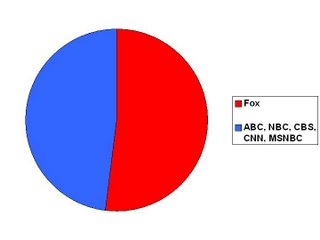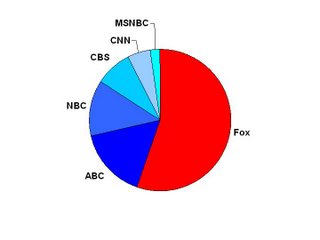Hugh and Omar focused on the elections and what they meant.
Yahoo focused on death and destruction. As of 0630 Pacific Time on April 23, 2006, Yahoo News' Iraq section featured the following headline: "Attacks continue after new Iraqi PM appointed." On Yahoo's front page news section, the only Iraq-related link was this: "3 GIs Killed by Roadside Bomb in Baghdad."
Anyone who says the news isn't colored by the editors is an idiot.
I was very angry about the way Yahoo chose to portray the news. I have many friends and colleagues in the Marines and Navy. They have worked very hard and the new government in Iraq is a big success for them. The media ignored their efforts and focused on their setbacks. Then something occurred to me about the news media's bias. This, too, in time shall pass. The news media is inexorably changing, becoming more fair and balanced as it were. The market will force it to do so and there's nothing that can stop it.
Let me explain.
Here are the last election results.

That is the market for news consumption. There are two ways to look at the way news stories are covered. Either news media organizations slant their stories to match their audience or the audience chooses the organization based on the way they slant the news. Either way, the result is the same. Here's where we are today.

The same demographic group is being served by five organizations while the largest group is served by one. Broken down by name, you get this.

I didn't bother to find the real breakdown of audience share, I was just trying to show the concept.
Of course, that's not where we are right now. Fox has nothing like that kind of audience share. However, what are the trends? Here's what I found on journalism.org's news media year in review.
Network evening news ratings continued to fall in 2005, another 6% November to November.That is right in line with what you would expect if the audience charts above were true. Fox currently has a monopoly on the largest section of the market while the other five fight over the smaller group.
...only one of the three main cable channels is growing: Fox, which now commands more than half the cable news audience at any one time (55% daytime and 59% prime time).
Does the news media understand what is going on? Yes they do. Again from journalism.org.
In our inaugural report, we suggested that the heart of that declining trust was a “disconnect” over motive. Journalists see themselves as acting on the public’s behalf. The public believes they are either lying or deluding themselves. There was further evidence of that skepticism in 2005. The Pew Research Center for the People and the Press found that 75% of Americans believed that news organizations were more concerned with “attracting the biggest audience,” while only 19% thought they cared more about “informing the public.”The italics above are mine.
The only fault I can find with this is that other than Fox, the news media is clearly not interested in attracting the biggest audience. I would argue that they are simply too incompetent to do so. If I had shown you the analysis above and had concealed the industry from you, you would conclude that the management of the five companies fighting over the smaller share were morons and needed to be fired. It's immediately obvious.
Corporations have cultural inertia that has to be overcome before a change can occur. Eventually, however, the market forces will drive one of them to change the way they report the news and become more conservative in their reporting.
Either that or Fox will simply crush them in the ratings. Either way, the market will take care of the problem.
No comments:
Post a Comment